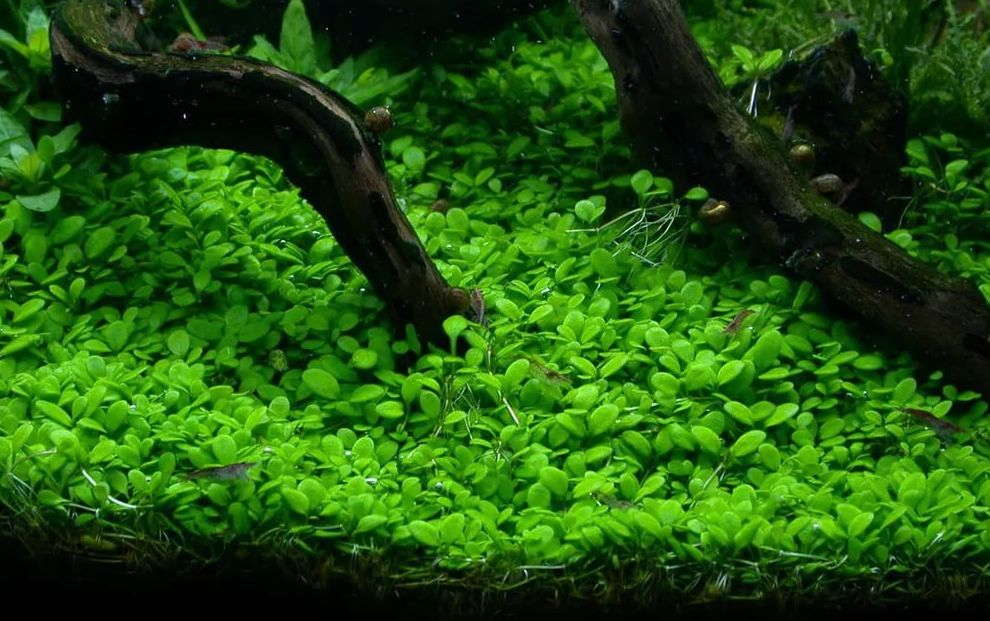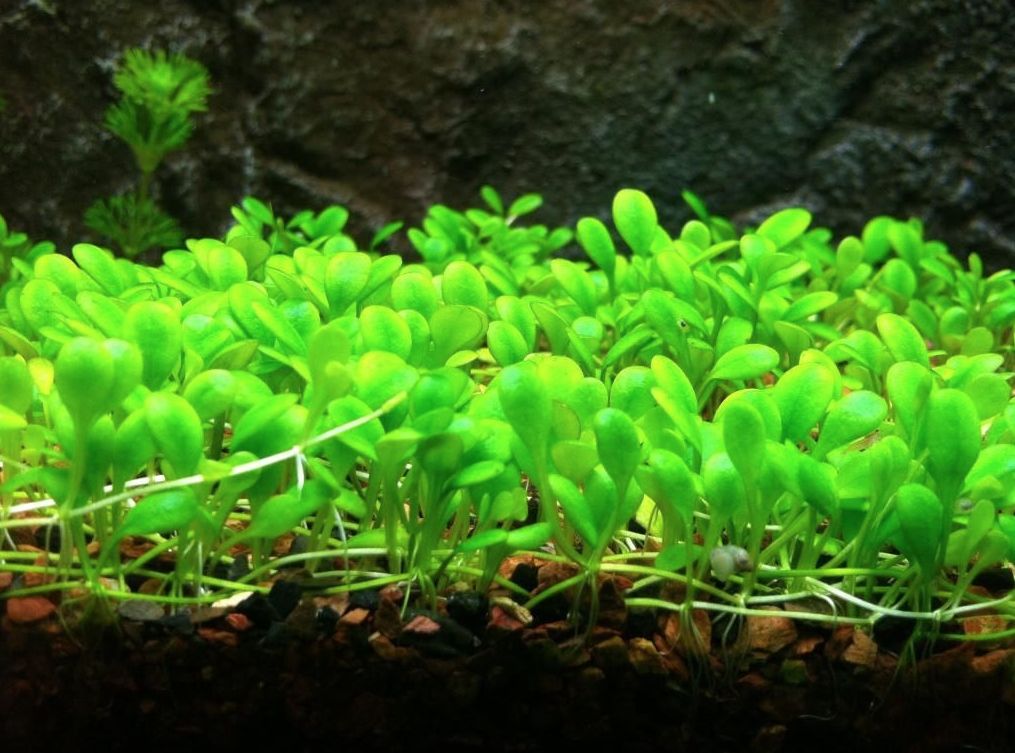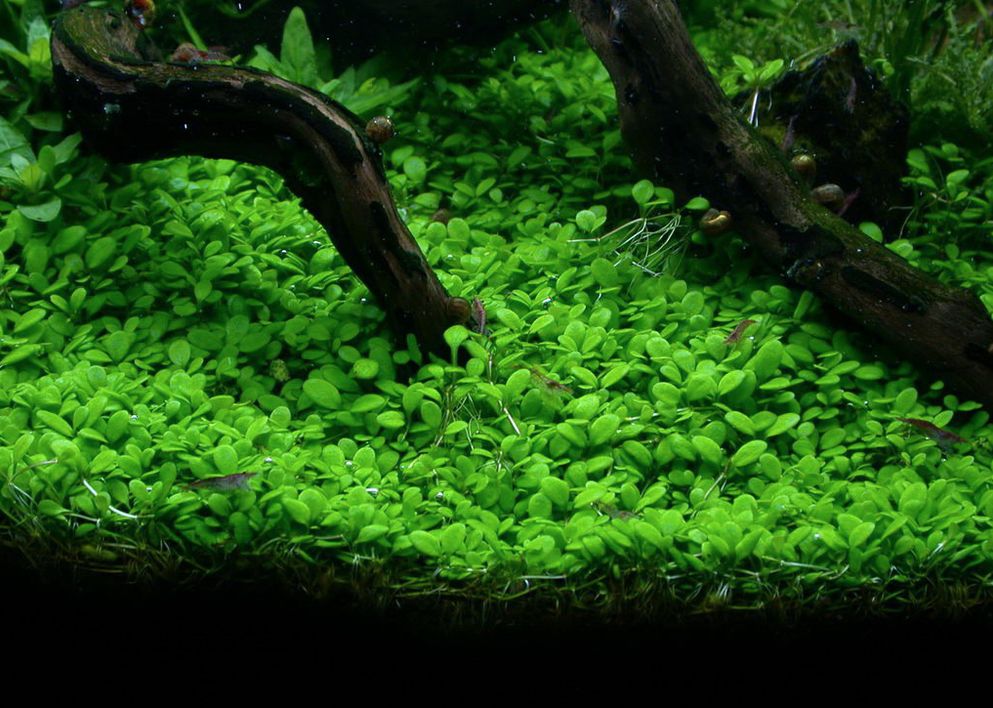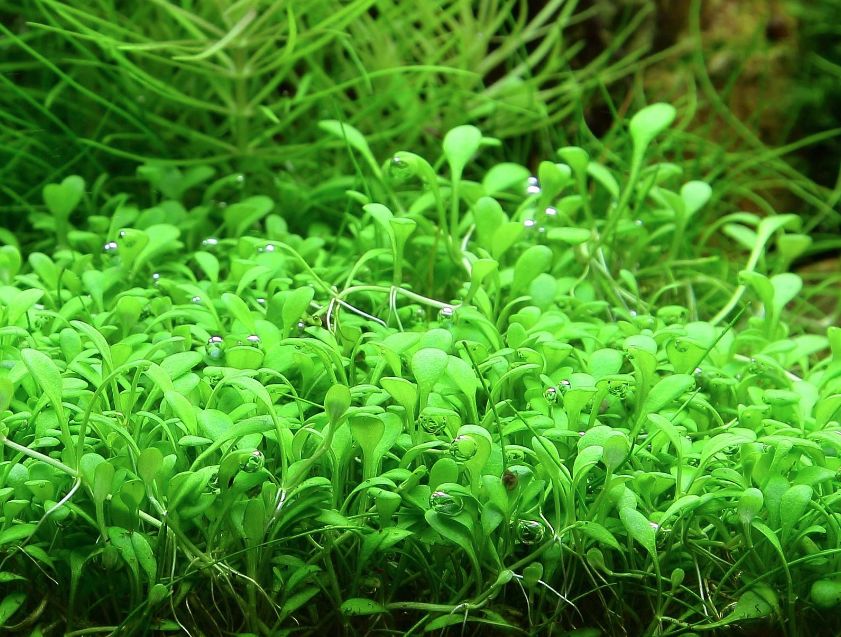Glossostigma elatinoides, commonly known as Glosso, is a popular and versatile aquatic plant species found in freshwater aquariums. Glossostigma elatinoides is one of the most popular fast-growing aquarium plants used in the foreground of a tank. This is a small green trailing plant with curly branches that form a very good-looking green carpet on the tank bottom.

Contents
Plant Habitat in the wild
The plant belongs to Scrophulariaceae family.
The plant has been known in aquarium hobby since 1980s, but it has already become one of the most popular tank plants among the professionals working with creating of planted or so called natural aquariums.
Glossostigma elatinoides originates from New Zealand, Tasmania and South-East Australia, where it grows next to water in bogs and lowlands. In the wild, Glossostigma elatinoides is typically found growing along the edges of streams, rivers, and other bodies of water with slow to moderate water flow.
Glossostigma elatinoides typically grows in areas with gentle to moderate water flow. It can be found along the edges of streams or in areas where water movement is not too strong. While it can tolerate some water flow, excessive currents may uproot or damage the delicate plants.
This is a beach plant by its nature and it gets flooded from time to time. That’s why it successfully grows out of water and in this case it blooms profusely in summer.

Description
Glossostigma elatinoides is a small sized plant and the carpet which it forms is very thin; it can be up to 1 cm thick. Its compact growth forms a tight mat of vegetation, covering the substrate and creating a visually appealing foreground.
The plant has rounded light green leaves up to 5 mm large. The length of its internodes is about 1 cm, but it can be about 5 cm long – which means that the plant spreads out around and above rather actively and this fact makes taking care about Glossostigma elatinoides carpet a bit specific.
The leaves are relatively flat and have a glossy, vibrant green color. They are arranged in opposite pairs along delicate stems.
Provided with favorable conditions bubbles of air may appear on its surface as a result of an active photosynthesis process occurring there. The plant grows quickly. Several bunches planted close to each other form a thick smooth green carpet in several weeks.
The leaves start to superimpose on one another and they resemble something like a green coat of mail from above.
| Feature | Glossostigma elatinoides |
|---|---|
| Common Name | Glosso |
| Origin | Australia, New Zealand, Tasmania |
| Growth Form | Ground-covering carpet plant |
| Leaf Size | Small, round or oval-shaped (< 1cm) |
| Leaf Color | Vibrant green |
| Growth Rate | Moderate to fast |
| Light Requirement | Moderate to high |
| CO2 Requirement | Beneficial but not mandatory |
| Water Temperature | 22°C to 28°C (72°F to 82°F) |
| pH Range | 6.0 to 7.5 |
| Water Hardness | Adaptable, prefers softer water |
| Propagation | Runners, division, and stem cuttings |
| Ideal Substrate | Nutrient-rich, fine-grained substrate |
| Water Flow | Moderate |
| Suitable for Beginners | Yes |
| Versatility | Suitable for foreground and carpeting |
| Maintenance | Regular trimming to maintain carpet |
| Compatibility | Compatible with most aquarium species |
| Ideal for Aquascaping | Yes |
Difficulties in keeping
Taking care about the plant is quite challenging and it isn’t likely to be within the power of a beginner aquarist. It requires high illumination level, quite soft (2 — 8°dKH) and slightly acidic (pH 5-7) water with temperature from 22 °C as well as occasional fertilization.
Despite the fact that the plant grows on the tank bottom, it requires high level of illumination, which must be taken into account when placing it in the tank.

Care and propagation in a tank
Lighting
Glossostigma elatinoides requires high lighting levels to thrive. Provide a lighting system that can deliver the required intensity and spectrum for optimal plant growth. LED lights designed for planted aquariums are recommended.
You can use glosso is aquascaping only at the condition of high illumination level in the tank. At that obtaining of the thick carpet is possible only when illumination value is more than 1 W/l as well as daylight duration isn’t less than 8 hours.
CO2
Although not mandatory, injecting carbon dioxide (CO2) can significantly enhance the growth of Glossostigma elatinoides. CO2 supplementation helps promote lush and compact growth. Consider using a CO2 system to maintain adequate carbon dioxide levels in the water.
Water Parameters
- Temperature: Maintain a temperature range of 22°C to 28°C (72°F to 82°F), which is suitable for most tropical aquarium setups.
- pH Level: Glossostigma elatinoides prefers a slightly acidic to neutral pH range of 6.0 to 7.5.
- Water Hardness: It can adapt to a wide range of water hardness levels but generally prefers softer water.
Substrate
Tank bottom substrate is the second important thing after the illumination level. It should have smooth edged grains about 2-3 mm large. The plant has very long and thin roots and soft substrate promotes deep penetration of the latter into it.
If there are some areas with large grained substrate in the tank, the plant can’t form a good looking carpet there – it either grows deep into the substrate, or forms its shoots high above it. By using such a substrate you can limit propagation of the plant, where you don’t need it.
Use a nutrient-rich substrate or a layer of aquasoil specifically designed for planted aquariums. This will provide essential nutrients for Glossostigma elatinoides’ growth and anchoring.
Fertilization
High illumination level requires additional CO2 supply (20-30 mg/l) and periodical fertilization, which is a must. Due to high growth rate of the plant, introduction of iron containing fertilizers is necessary to ensure saturated green coloring of the latter. Regularly provide essential nutrients to the plants through liquid fertilizers or root tabs. Look for fertilizers specifically formulated for aquatic plants and follow the dosage instructions.
Water Flow
Glossostigma elatinoides prefers moderate water flow. Ensure good water circulation in the aquarium, but avoid strong currents that may uproot or damage the delicate plant.

Glossostigma carpet
Glossostigma elatinoides is one of the fast growing aquarium plants, which as a rule grows about 2-3 cm (1 inch) tall. However, provided with high illumination level and additional CO2 supply it can grow even smaller.
The carpet requires trimming from time to time to maintain its proper appearance, otherwise the plant may tear off from the substrate and float to the water surface. This happens when the tank lighting and nutrients have poor access to the bottom level of the carpet and as a result this layer rots off. High growth rate leads to the situation when branches of horizontally growing shoots start to shade each other and grow longer to reach the light.
Therefore it is recommended to cut off vertically growing stems of the plant.
It is very easy to trim carpet. You should do this by holding scissors at an angle of 45 degrees, but you don’t have to be extra careful at that. If you accidentally tear some of the shoots off the substrate, don’t try to plant them back.
The plant won’t die at low level of lighting or without additional fertilization, but at such conditions it won’t behave as a ground-covering plant and it starts to grow upwards to reach the light, it becomes more than 10 cm long.

How to plant glossostigma elatinoides
When planting Glossostigma elatinoides you should divide it into separate verticils with two leaves each and plant them 1-2 cm far from each other. By means of pincers bury the stem completely into the substrate to make sure that the plant won’t float as well as that later it will strike roots to stick to the substrate firmly. Provided with proper care in about a month you will have a nice green carpet in your tank.
You should trim it from time to time, otherwise once it becomes about 5 cm tall, it may tear off from the substrate and float to the tank water surface. Glossostigma elatinoides propagates due to its trailing stem, its new small roots grow from it.
This way you will just break the wholeness of the substrate and the rest of the shoots will float as well. That’s why it is better just to cut off such a shoot.
To make sure that the plant forms a short nice green carpet, you have to cut off its old yellow rotten off leaves. If the plant leaves are severely infected with algae, remove such a bush and put a healthy one instead of it. Just a week later your small lawn will look as good as new.
Sources: